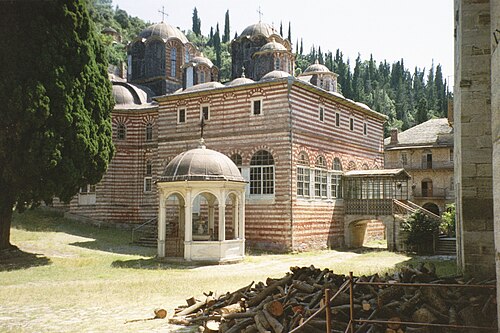
Hagia Sophia, officially the Hagia Sophia Grand Mosque and formerly the Church of Hagia Sophia, is a Late Antique place of worship in Istanbul. Built in 537 as the patriarchal cathedral of the imperial capital of Constantinople, it was the largest Christian church of the eastern Roman Empire and the Eastern Orthodox Church, except during the Latin Empire from 1204 to 1261, when it became the city's Roman Catholic cathedral. In 1453, after the Fall of Constantinople to the Ottoman Empire, it was converted into a mosque. In 1935 the secular Turkish Republic established it as a museum. In 2020, it re-opened as a mosque.

Ancient Roman architecture adopted the external language of classical Greek architecture for the purposes of the ancient Romans, but was different from Greek buildings, becoming a new architectural style. The two styles are often considered one body of classical architecture. Roman architecture flourished in the Roman Republic and even more so under the Empire, when the great majority of surviving buildings were constructed. It used new materials, particularly Roman concrete, and newer technologies such as the arch and the dome to make buildings that were typically strong and well-engineered. Large numbers remain in some form across the empire, sometimes complete and still in use to this day.

Romanesque architecture is an architectural style of medieval Europe characterized by semi-circular arches. There is no consensus for the beginning date of the Romanesque style, with proposals ranging from the 6th to the 11th century, this later date being the most commonly held. In the 12th century it developed into the Gothic style, marked by pointed arches. Examples of Romanesque architecture can be found across the continent, making it the first pan-European architectural style since Imperial Roman architecture. The Romanesque style in England is traditionally referred to as Norman architecture.

The architecture of cathedrals and great churches is characterised by the buildings' large scale and follows one of several branching traditions of form, function and style that derive ultimately from the Early Christian architectural traditions established in Late Antiquity during the Christianization of the Roman Empire.
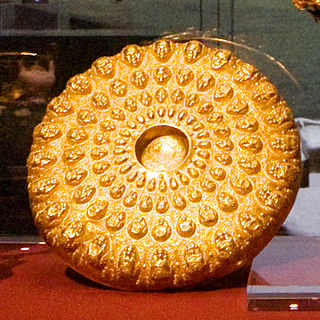
In the material culture of classical antiquity, a phiale or patera is a shallow ceramic or metal libation bowl. It often has a bulbous indentation in the center underside to facilitate holding it, in which case it is sometimes called a mesomphalic phiale. It typically has no handles, and no feet. Although the two terms may be used interchangeably, particularly in the context of Etruscan culture, phiale is more common in reference to Greek forms, and patera in Roman settings, not to be confused with the Greek (Πατέρας) Patéras or Father.

Byzantine architecture is the architecture of the Byzantine Empire, or Eastern Roman Empire.

In architecture, a clerestory is a high section of wall that contains windows above eye level. The purpose is to admit light, fresh air, or both.

The Bayezid II Mosque is an early 16th century Ottoman imperial mosque located in the Beyazıt Square area of Istanbul, Turkey, near the ruins of the Forum of Theodosius of ancient Constantinople.

A nymphaeum or nymphaion, in ancient Greece and Rome, was a monument consecrated to the nymphs, especially those of springs.
This page is a glossary of architecture.
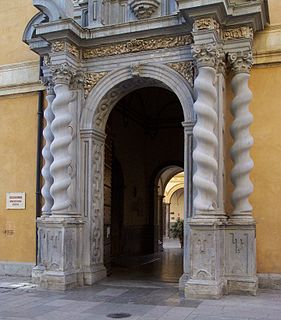
The Solomonic column, also called Barley-sugar column, is a helical column, characterized by a spiraling twisting shaft like a corkscrew. It is not associated with a specific classical order, although most examples have Corinthian or Composite capitals. But it may be crowned with any design, for example, making a Roman Doric solomonic or Ionic solomonic column.
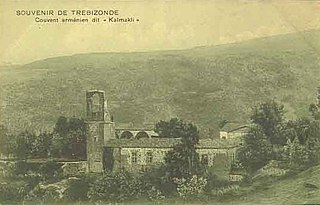
Kaymaklı Monastery is a ruined Armenian Apostolic monastery near Trabzon, Turkey.
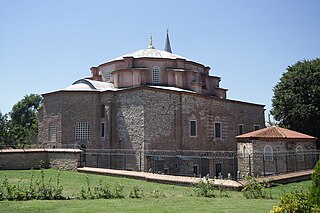
Little Hagia Sophia Mosque, formerly the Church of Saints Sergius and Bacchus, is a former Greek Eastern Orthodox church dedicated to Saints Sergius and Bacchus in Constantinople, built between 532 and 536, and converted into a mosque during the Ottoman Empire.

A vestibule, also known as an arctic entry, is an anteroom (antechamber) or small foyer leading into a larger space such as a lobby, entrance hall, passage, for the purpose of waiting, withholding the larger space view, reducing heat loss, providing space for outdoor clothing, etc. The term applies to structures in both Modern and Classical architecture since ancient times. In Modern architecture, vestibule typically refers to a small room next to the outer door and connecting it with the interior of the building. In ancient Roman architecture, vestibule referred to a partially enclosed area between the interior of the house and the street.

Italy has a very broad and diverse architectural style, which cannot be simply classified by period or region, due to Italy's division into various small states until 1861. This has created a highly diverse and eclectic range in architectural designs. Italy is known for its considerable architectural achievements, such as the construction of aqueducts, temples and similar structures during ancient Rome, the founding of the Renaissance architectural movement in the late-14th to 16th century, and being the homeland of Palladianism, a style of construction which inspired movements such as that of Neoclassical architecture, and influenced the designs which noblemen built their country houses all over the world, notably in the United Kingdom, Australia and the United States of America during the late-17th to early 20th centuries.

Fenâri Îsâ Mosque, in Byzantine times known as the Lips Monastery, is a mosque in Istanbul, made of two former Eastern Orthodox churches.

Church-Mosque of Vefa is a former Eastern Orthodox church converted into a mosque by the Ottomans in Istanbul. The church was possibly dedicated to Hagios Theodoros, but this dedication is far from certain. The complex represents one of the most important examples of Comnenian and Palaiologan architecture of Constantinople.

Koca Mustafa Pasha Mosque is a former Eastern Orthodox church converted into a mosque by the Ottomans, located in Istanbul, Turkey. The church, as the adjoining monastery, was dedicated to Saint Andrew of Crete, and was named Saint Andrew in Krisei or by-the-Judgment. Although heavily transformed during both the Byzantine and the Ottoman eras, it is one among the few churches in Istanbul still extant, whose foundation goes back to the sixth century.
The architecture of Rome over the centuries has greatly developed from Ancient Roman architecture to Italian modern and contemporary architecture. Rome was once the world's main epicentres of Classical architecture, developing new forms such as the arch, the dome and the vault. The Romanesque style in the 11th, 12th and 13th centuries was also widely used in Roman architecture, and later the city became one of the main centres of Renaissance and Baroque architecture. Rome's cityscape is also widely Neoclassical and Fascist in style.
